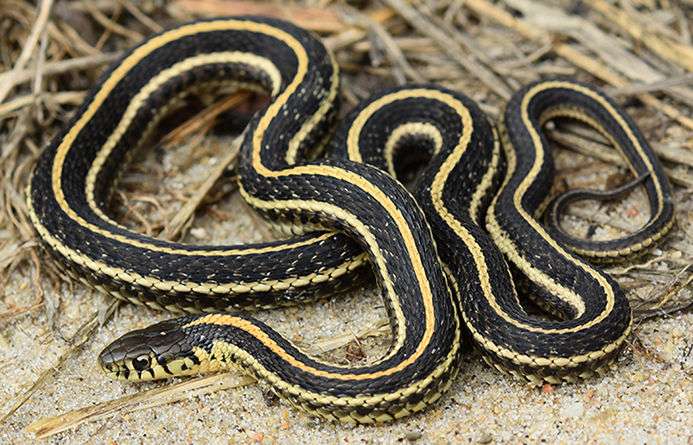
Description
Scientific Name: Thamnophis sp.
Lifespan: 10 years or more
Small to medium-sized snakes of the genus Thamnophis of the family Colubridae are sometimes referred to as “garter snakes.” Garter snakes range in size from little to medium. Although the pattern might change, the garter snake is identified by a pattern of three light stripes on a dark body. The snake’s back is divided into a thin center stripe and two wider side stripes. Usually yellow, the stripes can also be various colors of blue, green, or brown.
Native Region/Habitat
There are garter snakes in most of North America. Their vast spread is a result of their diverse diets and capacity to adapt to a variety of environments with variable distances from water. These snakes are more aquatic in the western than in the eastern parts of North America, though. Garter snakes can be found in a wide range of environments, such as woods, woodlands, fields, meadows, and lawns, but they are always close to water, frequently a nearby wetland, stream, or pond. This reflects the fact that a sizable portion of their diet consists of amphibians. Garter snakes are frequently discovered next to little ponds with dense weeds.
Behavior
Garter snakes are more active than most snakes during the day and through a larger range of temperatures. They hibernate from late October to early March or early April, however during the mild winter days, you can see them sunning on rocks. In natural crevices or tunnels, such as those found in mouse or crayfish burrows, under heaps of rocks, or under stumps, common garter snakes spend the winter. Some populations may have to travel fairly far from their summer feeding and breeding grounds to their hibernation habitats. Generally solitary, common garter snakes gather in huge groups in ideal locations for winter hibernation. They all hibernate at the same time to maintain the necessary body temperature for survival. Garter snakes may keep their bodies warm by coming together and coiling into tight rows.

Care as a Pet/In Captivity
Housing:
Garter snake housing is simple, and the optimal setup is a sizable plastic storage container with the right accessories. Depending on the size of the snakes, you’ll need at the very least 15 litres of space for each one. Smaller creatures won’t require as much room, while larger species will probably require twice as much. Having said that, their enclosure shouldn’t be too large either because that could make it hard for them to find their food.
Temperature and lighting:
Depending on their type and origin, your Garter will require a specific temperature. Generally speaking, a temperature of 70 degrees or less, with a warmer basking spot, is optimum. Direct illumination is not necessary; soft ambient light is ideal.
Feeding:
The best thing about garter snakes is that you don’t have to feed them pinky mice or mice, which deters many would-be snake keepers. Garters can be fed on small, live fish, snails, worms, and small frogs. The only challenging part of feeding them is that they require more frequent feedings than many other snake species, which can be difficult for owners.
Table





